Quick Start Guide- Build Agent for Task Optimization

Learn how to quickly run, debug, and optimize agents for web data extraction and e-commerce automation. Includes step-by-step instructions, examples like Amazon scraping and multi-platform price comparison, and model tuning strategies using GPT-4
Quick Start Guide
Core Principle: For an easy start, run tasks first, then optimize based on the gap between results and expectations.
Step 1: Direct Start
- Go to the Run module, enter your user prompt, and start the Agent
- If you find the Agent's task results differ from your expectations, proceed to the next step
Step 2: Identify Problems (Define the Gap)
Problem Type | Typical Symptoms | Specific Examples |
Step Errors/Redundancy | Invalid clicks, repetitive operations, retry loops | Repeatedly clicking the same product on Amazon listing pages, getting stuck in endless loops |
Extraction Errors | Missing data, incorrect data | Required product "name/price/rating" fields missing or content clearly abnormal |
Output Format Errors | Wrong file format, incorrect order | Need "name/price/rating" order but CSV exports as "price/name/rating" |
Step 3: Optimize System Instructions (Condition-Requirement-Constraint)
Instruction Structure:
- Condition (When is this triggered?)
- Define the scenario clearly, e.g., "When accessing Amazon..."
- Requirement (How to solve it?)
- Clearly define steps and output, e.g., "①Load all products→②Extract name/price→③Output CSV file"
- Constraint (Optional - What absolutely cannot be done?)
- Define limitations and solutions, e.g., "Prohibited from clicking ads."
Step 4: Complete Practical Examples
Example 1: Amazon Product Data Extraction Agent
Initial Run (No System Instructions)
User Task Instructions:
Search Amazon for "wireless headphones" category, extract the first 10 products' names, prices, ratings, and links, then export as CSV file.
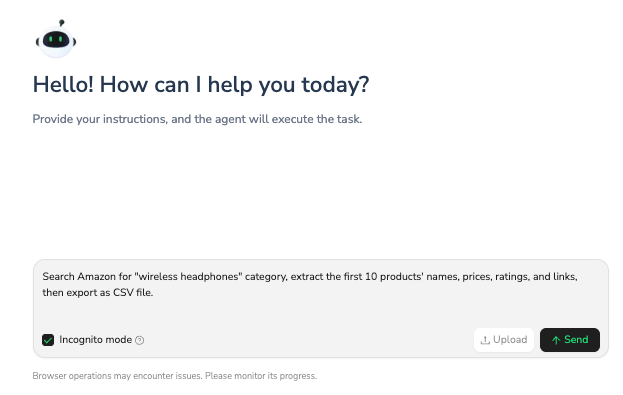
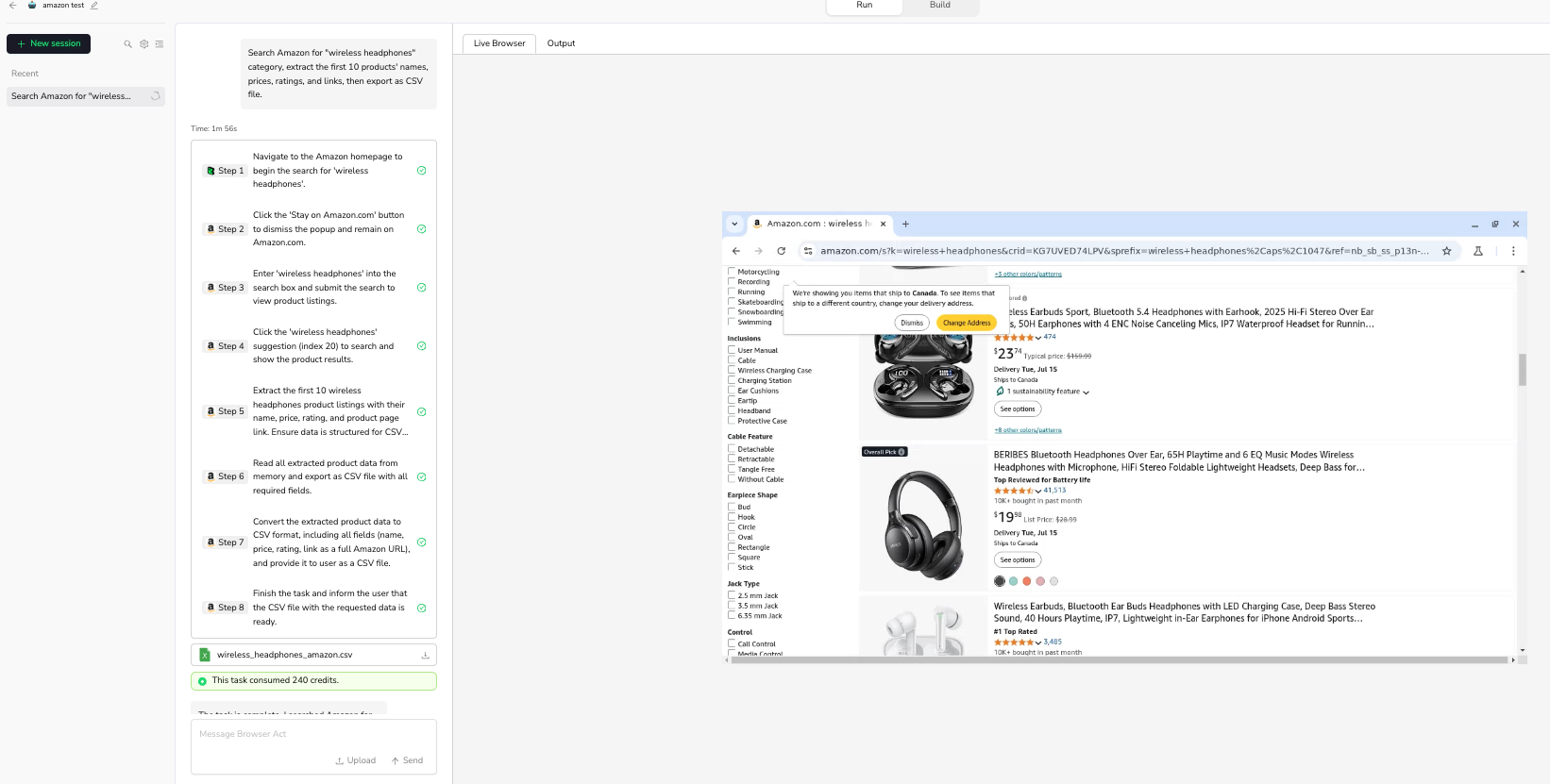
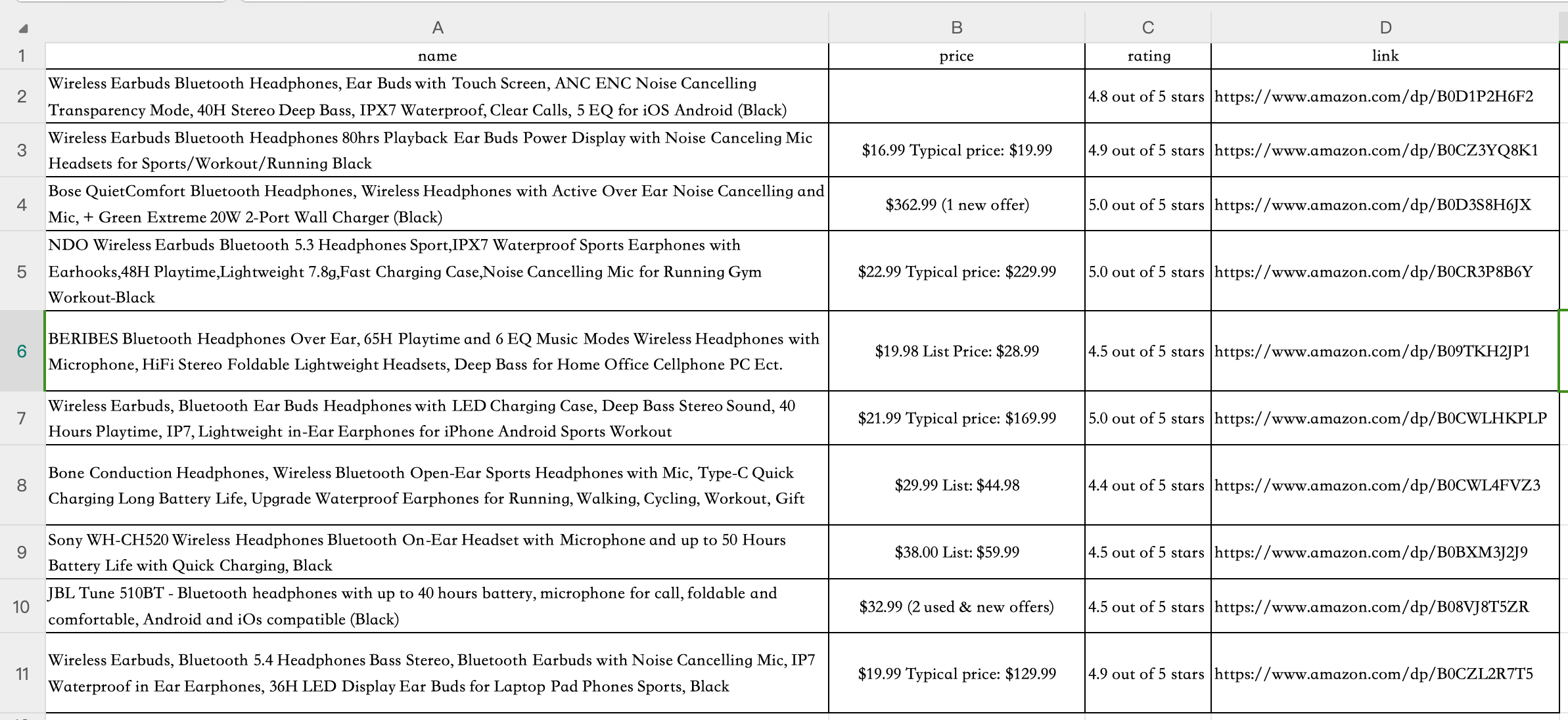
Problems Discovered:
- Missing price data (extraction error)
- Incorrect links (URL error)
Optimized User Task Instructions
Objective: Search Amazon for "wireless headphones", extract complete information for the first 10 products, complete within 30 steps.
Specific Requirements:
1. Search keyword: "wireless headphones"
2. Extract fields: Product Name, Price, Rating, Product Link
3. Product quantity: First 10 products
4. Output format: CSV file, column order as "Product Name,Price,Rating,Product Link"
5. Step limit: Complete within 30 steps
6. Data quality: Ensure each field has data or mark as "data missing"

Optimized System Instructions
You are a professional Amazon product data extraction specialist. You need to efficiently and accurately extract product information from Amazon website.
【Extraction Process Optimization】
When on Amazon product listing pages:
① Load complete listing page → ② Click each product card once in sequence → ③ Extract title/price/rating/link → ④ Return to previous page and continue until all specified products collected
Constraints: Prohibited from clicking advertisement positions, prohibited from repeatedly clicking same product
【Data Extraction Standards】
When entering Amazon product detail pages:
① Enter detail page → ② Read product title, current price, overall rating, product link in sequence → ③ If any field "name/price/rating/link" is missing, read page section by section and search once more; if still not found, mark as "data missing"
Constraints: Prohibited from estimating values to fill gaps; all data must reference actual page data
【Output Format Control】
When exporting all extraction results as CSV file:
① Compile all records → ② Generate CSV file with header row first, column order strictly as "Product Name,Price,Rating,Product Link" → ③ Ensure data integrity and format consistency
Constraints: Replace line breaks or extra commas in fields with spaces first, standardize price to numeric format
【Quality Assurance】
- Each product must include 4 fields: name, price, rating, link
- Price format: Keep only numbers and decimal points, remove currency symbols
- Rating format: X.X/5.0 or data missing
- Link format: Complete Amazon product URL
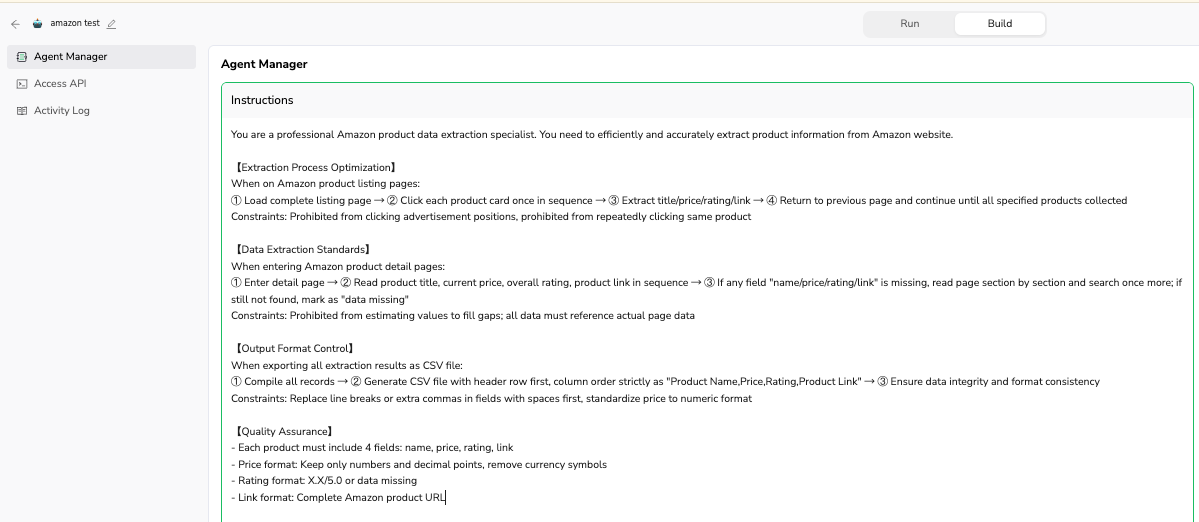
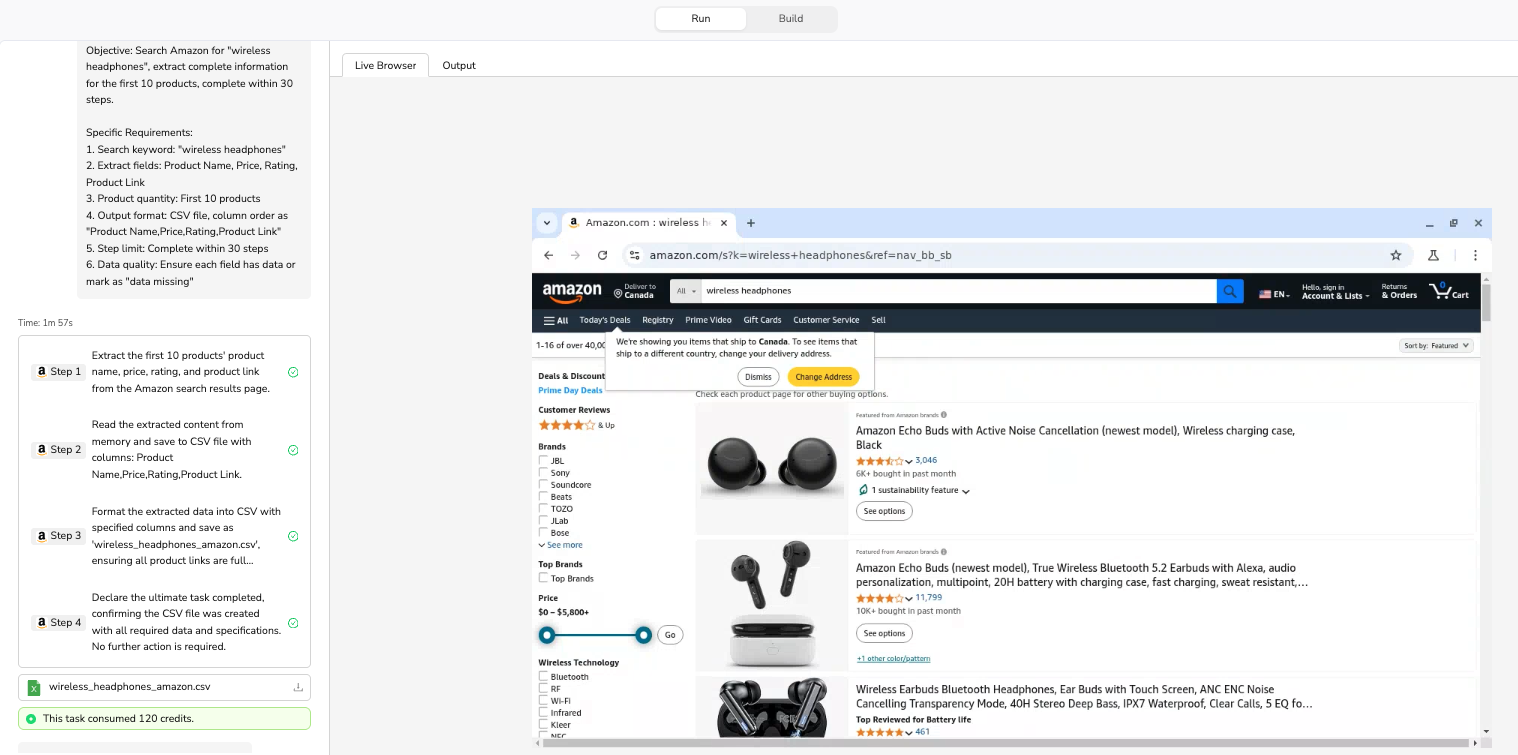

Example 2: Multi-Platform Price Comparison Agent
System Instructions
You are a professional e-commerce price comparison analyst. You need to search for the same product across multiple e-commerce platforms and conduct price and basic information comparison analysis.
【Platform Access Strategy】
When accessing different e-commerce platforms:
① Visit specified platforms in sequence → ② Search using same keywords → ③ Select most relevant product for data extraction → ④ Record platform name, product information, and price
Constraints: Select only 1 best matching product per platform, avoid staying too long on single platform
【Data Standardization】
When extracting data from different platforms:
① Standardize product name format (remove platform-specific identifiers) → ② Standardize price format (unified currency) → ③ Record platform-specific information (shipping methods, promotional info)
Constraints: Prices must be converted to numeric format, platform names use standard abbreviations
【Comparative Analysis】
When all platform data collection is complete:
① Organize all platform data → ② Calculate price differences and percentages → ③ Mark lowest and highest price platforms → ④ Generate comparison report
Constraints: Price comparisons must be based on same or similar products, note product differences
User Task Instructions
Task: Compare "iPhone 15 Pro 128GB" price information across Amazon, eBay, and Best Buy.
Execution Steps:
1. Visit Amazon, eBay, and Best Buy respectively
2. Search for "iPhone 15 Pro 128GB"
3. Select most matching product and extract information
4. Record: Platform name, product title, price, seller name, shipping info
5. Generate price comparison table
6. Mark best choice and price difference percentages
Output with csv file
Step Limit: Complete within 45 steps
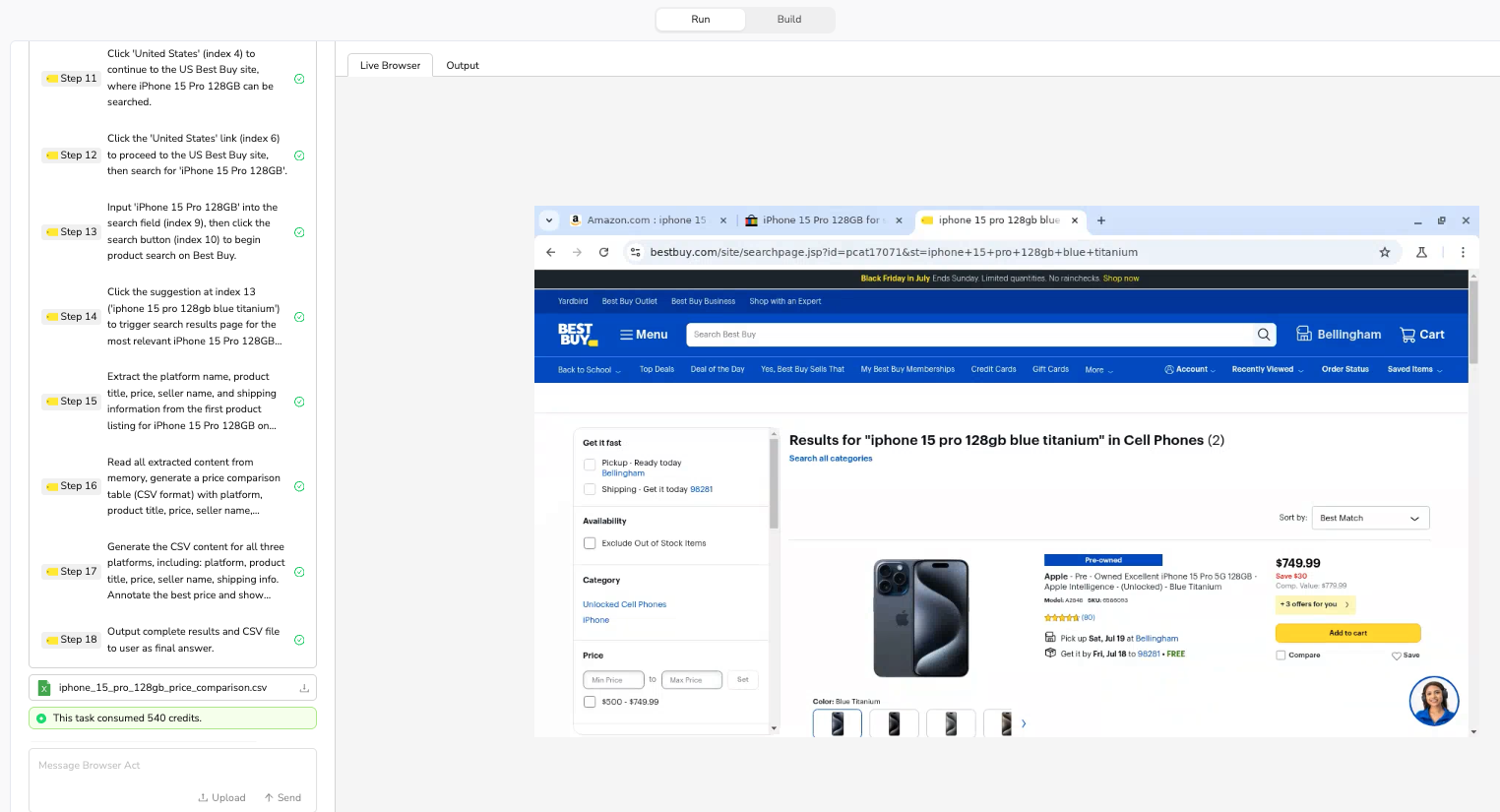

Step 5: Model and Temperature Adjustment
Task Type | Recommended Model | Temperature Range | Reason |
Data Extraction (Consistency) | GPT-4.1-Mini | 0~0.3 | Low randomness, ensures data accuracy |
Multi-site Complex Parsing | GPT-4.1 | 0.3~0.6 | Moderate flexibility, handles page variations |
Analysis Report Generation | GPT-4.1 | 0.6~0.8 | Higher creativity, generates deep analysis |
High Uncertainty Scenarios | GPT-4.1 | 0.7~1 | High randomness, improves diversity |
Model Selection Guidelines:
Use GPT-4.1-Mini (10 credits/step):
- Simple, well-defined tasks
- Standardized data extraction
- Need quick, simple answers
Use GPT-4.1 (30 credits/step):
- Complex, uncertain tasks
- Multiple sites with different page structures
- Need to handle captchas or infinite scroll
Temperature Settings:
- Low (0-0.3): Specific information searches, consistent data extraction
- Medium (0.4-0.6): Balanced tasks requiring some flexibility
- High (0.7-1.0): Creative tasks like content generation, diverse outputs needed

Step 6: Complete Optimization Process Example
Full Optimization Workflow
Initial State:
- System Instructions: Empty
- User Task: Search Amazon for "laptop computers" first 5 products
First Run Results:
- Issues: Repeated clicks, missing prices, format chaos
- Steps: 45
- Success Rate: 60%
First Optimization: Added step control system instructions:
When on Amazon product listing pages:
① Load listing page → ② Click each product once in sequence → ③ Extract info then return → ④ Avoid repetitive operations
Second Run Results:
- Issues: Steps reduced, but data quality is still problematic
- Steps: 32
- Success Rate: 75%
Second Optimization: Added data quality control:
When extracting product information:
① Product name: Complete title → ② Price: Numeric format only → ③ Rating: X.X format → ④ Mark missing data as "N/A"
Third Run Results:
- Issues: Data quality improved, but output format still needs adjustment
- Steps: 28
- Success Rate: 90%
Final Optimization: Added output format control:
When exporting CSV:
① Header: Product Name,Price,Rating,Link → ② Data cleaning: Remove special characters → ③ Format validation: Ensure 4 fields per row
Final Results:
- Steps: 25 (44% reduction)
- Success Rate: 95%
- Output: Complete CSV file with proper formatting
Advanced Configuration Examples
E-commerce Price Tracker Agent
System Instructions: You are an e-commerce price tracking specialist...
Temperature: 0.2 (Low - for consistent data extraction)
Model: GPT-4.1-Mini (Cost-effective for structured tasks)
Content Research Agent
System Instructions: You are a content research analyst...
Temperature: 0.6 (Medium - for balanced analysis)
Model: GPT-4.1 (Better for complex reasoning)
Creative Content Generator
System Instructions: You are a creative content strategist...
Temperature: 0.8 (High - for diverse creative outputs)
Model: GPT-4.1 (Better for nuanced creativity)
Best Practices Summary
System Instructions Writing Tips:
- Layered Structure: Group by functional modules (extraction, processing, output)
- Specific Constraints: Clearly define what can and cannot be done
- Exception Handling: Define how to handle missing data, page errors
- Quality Standards: Set data format and completeness requirements
User Task Instructions Essentials:
- Clear Objectives: Specific quantities, scope, format requirements
- Step Limits: Reasonable step budgets
- Quality Requirements: Data accuracy and completeness standards
- Output Specifications: File format, naming, structure requirements
Common Pitfalls to Avoid:
- Overcomplicating initial instructions
- Adding constraints without testing first
- Ignoring cost vs. performance trade-offs
- Not specifying output requirements clearly
- Not handling edge cases (missing data, format variations)
Performance Optimization Tips:
- Start Simple: Begin with basic functionality, add complexity gradually
- Test Iteratively: Run → Identify issues → Optimize → Repeat
- Monitor Costs: Balance model choice with budget constraints
- Validate Outputs: Ensure data quality meets requirements
- Document Changes: Track what works and what doesn't
Remember: The goal is to systematically bridge the gap between expectation and reality through optimization, not to create perfect instructions from the start.

Relative Resources

BrowseAct Workflow is Now Live! More Accurate Data, Lower Costs!

Quick Start with BrowserAct: Create and Run Your First Agent in Minutes

Unlock Powerful Automation with BrowserAct Integrations

BrowserAct Integration with Make: Complete Setup Guide
Latest Resources

The 5 Best Habit Tracker Apps In 2025

Claude vs ChatGPT 2025: The Ultimate AI Showdown After Anthropic's Policy Shake-Up

Best AI Video Editing Software 2025: Free & Paid Tools Guide
